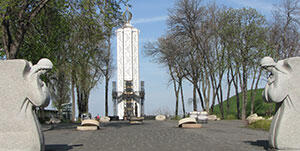
 On June 24, 2015 the Holodomor Atlas, a unique online resource, was presented in Kyiv at the National Memorial Museum of Holodomor Victims in Ukraine. It is a result of collaboration between Harvard Ukrainian Research Institute and a group of historians, demographers and other experts from different institutions in Ukraine, and presents an interactive GIS-based series of maps of the Great Ukrainian Famine of 1932-1933.
On June 24, 2015 the Holodomor Atlas, a unique online resource, was presented in Kyiv at the National Memorial Museum of Holodomor Victims in Ukraine. It is a result of collaboration between Harvard Ukrainian Research Institute and a group of historians, demographers and other experts from different institutions in Ukraine, and presents an interactive GIS-based series of maps of the Great Ukrainian Famine of 1932-1933.
The Atlas was designed as an innovative, interactive resource to research the long-lasting demographic consequences of the most tragic event of the Ukrainian history. Using the administrative division of Ukraine in 1933, this unique collection of demographic maps tracks population losses to famine region by region and clearly illustrates where the greatest loss of life occurred in relation to a variety of factors such as level of collectivization, blacklisting, and many other economic, political, administrative and geographic characteristics.
A gallery of interactive GIS maps of Ukraine allows researchers to compare, distribute and integrate various political, economic, demographic, environmental, and other data on the national, regional and local levels.
Also included in a GIS database are historical maps, a selection of authentic period photos, and an article by Serhii Plokhii, “Mapping the Great Famine" a detailed analysis of the geography of the Holodomor and factors that determined population losses, based on the variety of archival materials, including eyewitness accounts.
A work in progress, the Atlas has been in development since 2010 and serves as an interdisciplinary, interactive online resource that is constantly expanded as new data becomes available.